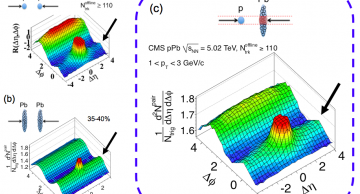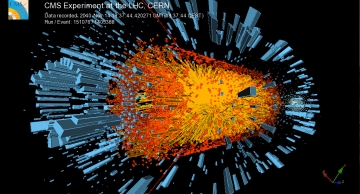In 2011, CMS presented early evidence that Upsilon (Υ) particles produced in lead-lead collisions “melt” as a consequence of interacting with the hot nuclear matter created in these heavy-ion interactions. CMS has since updated and extended this…
CMS has published its first paper on proton-lead (pPb) collisions, describing the observation of a phenomenon that was previously seen first in nucleus-nucleus collisions but also detected by CMS in proton-proton (pp) collisions. The effect is a…
In our Universe today, quarks are always bound together by gluons to form "composite" particles such as protons and neutrons. The Quark-Gluon Plasma, or QGP, often described as a soup-like medium, is a hot, dense state in which these quarks and…
After only three weeks of heavy-ion running at CERN’s Large Hadron Collider (LHC), the CMS experiment is already yielding new insights into the condition of matter that existed in the very first instants of the Universe’s life, some 13.7 billion…
The CMS experiment at CERN's Large Hadron Collider (LHC) has recorded its first Lead-Lead collisions at a centre-of-mass energy of 2.76 TeV per nucleon pair, marking the start of its heavy ion research programme. Physicists around the world expect a…





